19 Task 1. Energy conversion – energy from the wind
Aim of the task
The aim of the task is to learn about selected aspects of energy conversion. Considered problem regards the conversion of primary energy like a wind energy into electrical energy. The task includes the analysis of the following issues: efficiency of conversion, annual production, mean time of use.
Introduction
Nowadays wind energy has become an increasingly popular source of sustainable energy, mainly because of successful efforts to increase the efficiency conversion from wind energy into electricity. All an apparatus for converting the kinetic energy available in the wind to mechanical energy that can be used to power machinery and to operate an electrical generator is called wind energy conversion system (WECS). In the field of electrical power engineering, the wind energy conversion system is simply referred to as wind turbine. General practice is to use horizontal axis wind turbines with three blades. A schematic representation of the wind turbine is shown in Fig. 1.1.
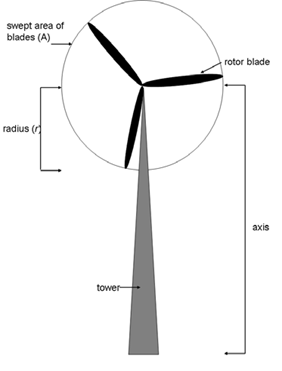
In recent years, the development of wind turbine technologies has been observed. In the last 3–4 decades, the wind turbine capacity has been increased around 30–100 times. Development of wind turbines has been shown in Fig. 1.2.
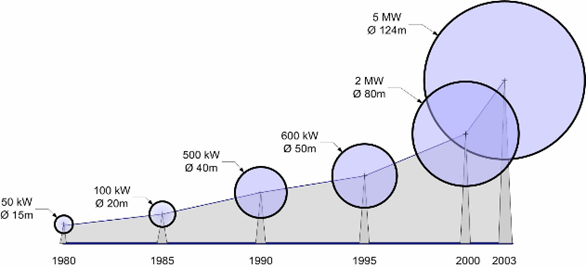
An important factors related to the wind that influence the amount of generated electricity produced by wind turbines are:
- mean wind-speed at tower height
 ,
, - variation in wind speed over time
 ,
, - mean air density
 .
.
If wind speeds throughout a year will be measured, it will be found that in most areas strong gale force winds are rare, while moderate and fresh winds are quite common. The wind variation for a typical site is usually can described using the Weibull distribution, as shown in the Fig. 1.3.
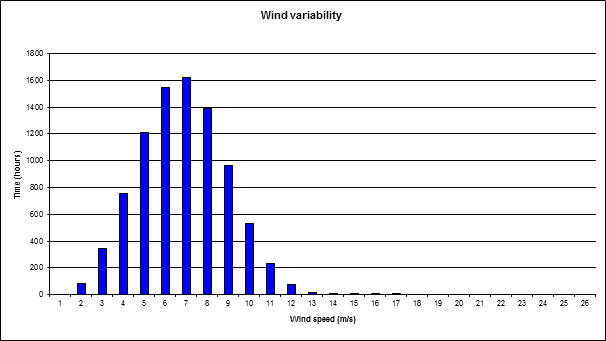
Power from the wind
a) wind power
The power in the wind  which is available by a wind turbine with a rotor surface
which is available by a wind turbine with a rotor surface  (Fig.1 .4) can be determined using the following formula:
(Fig.1 .4) can be determined using the following formula:

where
• ![]() is the power in the wind [W]
is the power in the wind [W]
• ![]() is the density of dry air at sea level at mean [kg/m3] (for atmospheric pressure and an air temperature of 15oC)
is the density of dry air at sea level at mean [kg/m3] (for atmospheric pressure and an air temperature of 15oC)
• ![]() is the mean wind speed at tower height [m/s]
is the mean wind speed at tower height [m/s]
• ![]() is the surface area of the circle that is swept by the rotor blades with radius
is the surface area of the circle that is swept by the rotor blades with radius ![]()
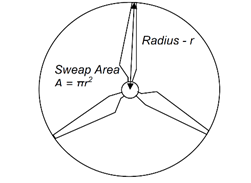
b) available power
Not all kinetic energy in a column of wind is extracted by a wind turbine. There is always some energy left in the wind behind the wind turbine. Therefore, one can conclude that only a certain fraction of the wind energy is extracted. This fraction is referred to as the conversion coefficient ![]() . In theory, the highest possible value of
. In theory, the highest possible value of ![]() is
is ![]() (Betz’ law). In practice
(Betz’ law). In practice ![]() usually is approximately 0.5.
usually is approximately 0.5.
Part of the extracted wind power is subsequently lost by mechanical friction in the turbine and energy conversion in the generator. Hence the efficiencies of turbine and generator should be taken into consideration. Therefore, the maximal available power extractable from the wind can be estimated as follows:

where
![]() – is wind conversion efficiency
– is wind conversion efficiency
![]() – turbine mechanical efficiency
– turbine mechanical efficiency
![]() – generator conversion efficiency
– generator conversion efficiency
c) electric power
Wind turbine system is designed in specific manner. The typical wind turbine output electric power curve is shown in Fig. 1.5.
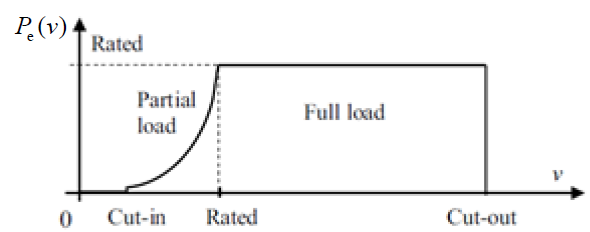
Fig. 1.5. Wind turbine output power curve Pe (v) (wind turbine output electric power as a
function of wind speed).
The wind turbine operates, with different dynamics, from the cut-in wind speed (usually 3–4 m/s, for modern wind turbines) to the cut-out wind speed (around 25 m/s), as shown in Fig. 1.5. The output power evolves until it reaches the wind turbine rated power. This happens at rated wind speed vn, which splits the wind turbine operation range in two: below rated (also called partial load region) and full load region, where the captured power must be limited to rated. The ![]() characteristic of the wind turbine is specified by the manufacturer.
characteristic of the wind turbine is specified by the manufacturer.
Calculation
a) Wind energy conversion efficiency
The efficiency of conversion of wind energy into electrical energy can be calculated as follows:

b) annual electrical energy production
Basing on wind energy variability characteristic![]() , the annual electrical energy production
, the annual electrical energy production ![]() from the wind can be calculated as follows:
from the wind can be calculated as follows:

![]() – electric power generated wind turbine in case of wind speed equals to
– electric power generated wind turbine in case of wind speed equals to ![]() ,
,
![]() – period of time corresponding to wind speed
– period of time corresponding to wind speed ![]() , where
, where  .
.
c) Mean power generated and mean time of use
Mean power generated by wind turbine can be calculated as follows:

Mean time of use of rated power of wind turbine

where ![]() is rated power of the wind turbine.
is rated power of the wind turbine.
Example:
Using a turbine with an 80 meter rotor diameter as an example, the amount of wind power Pwind available in a 20 mph (9,8 m/s) wind for this turbine with 5027 m2 of swept area is:
Pwind = ½ × 1,2 kg/m3 × π × (40 m)2 × (8,9 m/s)3 = 2,3 × 106 kg·m2/s3 = 2,3 MW $.
References
[1] Machowski J, Bialek J, Bumby J. Power system dynamics: stability and control. New York, USA: John Wiley & Sons; 2008.
[2] Brendan Fox ; Leslie Bryans ; Damian Flynn ; Nick Jenkins ; David Milborrow ; Mark O’Malley ; Richard Watson ; Olimpo Anaya-Lara: Wind Power Integration: Connection and System Operational Aspects. IET London, 2007.
Exercise
Content and input data:
The input data are as follows:
- characteristic of the wind speed
 ,
, - wind turbine parameters: rotor diameter
 , rated power
, rated power , output power curve
, output power curve  ,
, - air density
 kg/m3.
kg/m3.
To do:
- Calculate and plot the value of efficiency of energy conversion as a function of wind speed.
- Calculate and plot curves of the wind power and electrical power (at the same figure).
- Calculate the annual mean power generated by wind turbine.
- Calculate the annual mean time of use of rated power of wind turbine.
- Prepare a report and formulate brief conclusions.
